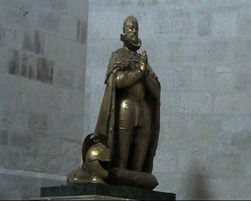Denia and the rise of its Marquis
 Francisco Gómez de Sandoval y Rojas was born in TordesillasTordesillas is a town located in the current region of Castilla y León, in the province of Valladolid. It is famous for the Treaty of Tordesillas (1494) between the crowns of Castile and Portugal, which divided the non-European world between the two great colonial powers of the time. In the fortress of Tordesillas Joanna the Mad (1479-1555), Queen of Castile and mother of Charles V was confined for a long time. in 1553, the heir of one of the oldest and most prestigious noble clans of the Iberian Peninsula. However, following the dynastic struggles that had divided the kingdom of Castile in the fifteenth century, the Sandovals had lost most of their possessions, only preserving properties in the Crown of Aragon. The main title of the family was a marquisate, which was held in Denia, in the kingdom of Valencia, but the recovery of the titles and patrimony which had been lost in the previous century constituted a constant goal for Don Francisco, the fifth Marquis of Denia. As a Grandee of SpainTheGrandeza de España is the highest honour reserved for the Spanish nobility. It is granted by the king, generally together with a title of nobility, and can be hereditary or for life. Its storied origin goes far back to the period of the Visigoth monarchy, although it was Charles V (1500-1558) who initiated the concession of the Grandeza. The emperor granted such honours, which were linked to various rights and privileges, to the members of Castilian aristocracy who had remained loyal during the uprising of the comuneros (1520-1521). in any case he had access to the private rooms of the monarch and his family, and so it was that the Marquis was able to approach the heir to the throne, the future Philip III, and in a short time win his trust and affection. The close link with the prince, strengthened by the continued closeness and sharing of passions, habits, and some vices, caused the suspicions of the king, Philip II, and the men who surrounded him in his last years of his reign. With an aim to removing him from his young and inexperienced heir, the king appointed the Marquis of Denia as viceroy of Valencia, in 1595. During the following two years, the new viceroy could be close to his Valencian possessions, strengthening its delicate financial situation and worrying at the same time about maintaining close relations with the prince, through relatives and allies who were at the court. Called to Madrid in 1597 for alleged health reasons, Denia finally prevailed as the future king’s favourite. He was confirmed as Caballerizo mayor, or as the of the primary courtiers charged with accompanying the prince in his horseback riding. 13 September, 1598, the day of the death of Philip II, marked the beginning of a new phase in the history of the Spanish Monarchy.
Francisco Gómez de Sandoval y Rojas was born in TordesillasTordesillas is a town located in the current region of Castilla y León, in the province of Valladolid. It is famous for the Treaty of Tordesillas (1494) between the crowns of Castile and Portugal, which divided the non-European world between the two great colonial powers of the time. In the fortress of Tordesillas Joanna the Mad (1479-1555), Queen of Castile and mother of Charles V was confined for a long time. in 1553, the heir of one of the oldest and most prestigious noble clans of the Iberian Peninsula. However, following the dynastic struggles that had divided the kingdom of Castile in the fifteenth century, the Sandovals had lost most of their possessions, only preserving properties in the Crown of Aragon. The main title of the family was a marquisate, which was held in Denia, in the kingdom of Valencia, but the recovery of the titles and patrimony which had been lost in the previous century constituted a constant goal for Don Francisco, the fifth Marquis of Denia. As a Grandee of SpainTheGrandeza de España is the highest honour reserved for the Spanish nobility. It is granted by the king, generally together with a title of nobility, and can be hereditary or for life. Its storied origin goes far back to the period of the Visigoth monarchy, although it was Charles V (1500-1558) who initiated the concession of the Grandeza. The emperor granted such honours, which were linked to various rights and privileges, to the members of Castilian aristocracy who had remained loyal during the uprising of the comuneros (1520-1521). in any case he had access to the private rooms of the monarch and his family, and so it was that the Marquis was able to approach the heir to the throne, the future Philip III, and in a short time win his trust and affection. The close link with the prince, strengthened by the continued closeness and sharing of passions, habits, and some vices, caused the suspicions of the king, Philip II, and the men who surrounded him in his last years of his reign. With an aim to removing him from his young and inexperienced heir, the king appointed the Marquis of Denia as viceroy of Valencia, in 1595. During the following two years, the new viceroy could be close to his Valencian possessions, strengthening its delicate financial situation and worrying at the same time about maintaining close relations with the prince, through relatives and allies who were at the court. Called to Madrid in 1597 for alleged health reasons, Denia finally prevailed as the future king’s favourite. He was confirmed as Caballerizo mayor, or as the of the primary courtiers charged with accompanying the prince in his horseback riding. 13 September, 1598, the day of the death of Philip II, marked the beginning of a new phase in the history of the Spanish Monarchy.
